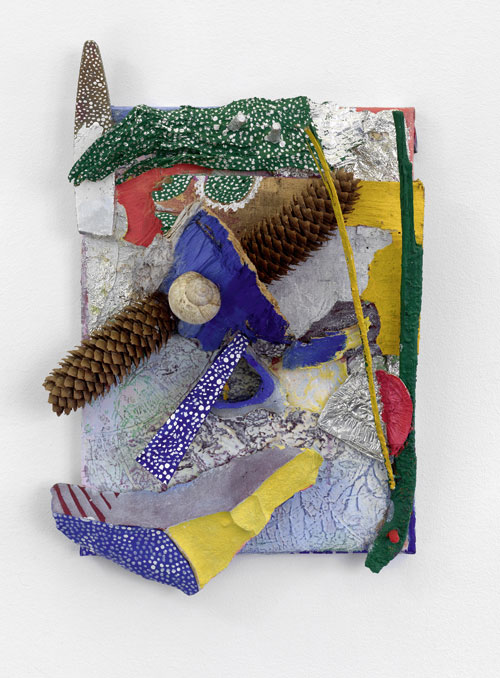Michael Buthe
Galerie Thomas Flor
Galerie Thomas Flor

The early 1970s was a period of transgression for young German artists. Sigmar Polke travelled from provincial Düsseldorf to Afghanistan, took mind-altering drugs and photographed bear fights in the mountains. His contemporary Michael Buthe, having spent the late 1960s dismantling painting by draping tie-dyed rags over stretchers, absconded from Cologne to Morocco, the land William Burroughs had celebrated for its drugs and gay sex. On Buthe’s return, his materialistic painting quickly expanded into installations riddled with esoteric narrative elements. The self-reflexive rigour of the late 1960s had succumbed to hippy transcendentalism.
In the ten works Thomas Flor selected from those Buthe painted in the early 1990s – shortly before his death in 1994 – this confluence of materialistic, fantastic and deconstructive strains had recoalesced into paintings which had absorbed the atomized, astylistic complexity of Gerhard Richter’s 1980 abstract paintings, as well as Anselm Kiefer’s use of chemically-patinaed lead grounds. But even Richter’s aleatoric process was subject to a far more linear narrative (albeit one characterised by paradox and oxymoron) and whereas Polke never forsook his Pop art roots, the heterogeneity of Buthe’s abstraction – at least in this final cycle – remains self-referential, even solipsistic. In the late 1980s, he had juxtaposed found portrait images in crowded configurations overlaid with hand-painted dot screens. But, despite their photographic ground, these dots had remarkably little to do with Polke’s or Roy Lichtenstein’s Ben-Day dots – the Pop art substitute for half-tone printing – but instead resembled stars; apotheosizing the subjects of the photographs, rather than designating them as reproductive cyphers.

Fittingly then, by the early 1990s, the photographic images had been rejected while the star/dots remained, as if Buthe had wanted to concentrate what was specifically his. His wooden frames, painted as part of the works, are so deep they seem designed to shelter the canvases, protecting the fragility of their pictorial worlds. Untitled (R077) (1992) has wedges of timber, and what looks like painted hard-boiled eggs, affixed to its canvas; but these collage elements are difficult to make out – unwieldy as they are – as they have been subsumed by clashing colour registers. Buthe would lay paper over a surface he had lathered with acrylic paint, then remove it, allowing the surface to dry into ridges – a hands-off gesture equivalent to the drag of Richter’s squeegy. He would then rhetorically negate the untouchedness of the effect by hand-colouring its depressions in a contrasting colour, so the ridges of paint are isolated as a web. The contingency of natural process – a familiar painterly trope of early-1990s abstraction – is radically claimed as design.
Buthe’s free-ranging technique is as startling and iconoclastic in our contemporary context – in which painting tends to be the result of a recipe for a recognizable product – as his late rejection of Postmodern image reference. These paintings are neither cool, nor conceptual, nor ironic, and they show no impulse to present themselves as self-reflexive or context-reflexive metaphor. They aim at generating not critique but astonishment. The challenge appears to be to find a reconciliation of a maximum homogeneity of surface incident. Added elements – pine cones, broomsticks, sea shells and great splats of crumpled aluminium foil – do not breach a painting’s autonomy, but populate it. Another untitled painting, from 1992, has its all-over imprint of ultramarine decorated with silver paint, like a skin of wrinkled foil, to which blocks of wood wrapped in real foil were subsequently attached. It is through such inconsequential formal connections – aloof from extra-painterly concepts or agendas – that Buthe operates. The innocence of the work, its voluntary surrender to a campy glamour, its obliviousness to good taste and its shameless attempt to seduce-by-all-means are indistinguishable from its desperation. It reminds us that art is not a question of making something that looks good, but something which challenges what looking good might mean, and involves discovering it afresh.















